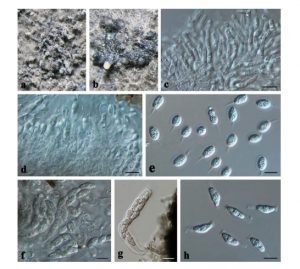Phyllosticta dendrobii S. Lin, Y. Zhang ter, sp. nov., MycoBank: MB821784
Etymology : Named after the host genus from which it was collected, Dendrobium nobile.
Conidiomata pycnidial, mostly aggregated in clusters, black, erumpent, globose to clavate or elongated with necks up to 700 μm long, exuding colourless to opaque conidial masses. Pycnidia up to 280 μm diam. Pycnidial wall of several layers of textura angularis, up to 40 μm thick, inner wall of hyaline textura angularis. Ostiole central, up to 20 μm diam. Conidiophores reduced to conidiogenous cells, Conidiogenous cells terminal, subcylindrical, hyaline, smooth, 6–10 × 3–4 μm, proliferating several times percurrently near apex. Conidia (5–)8–9(–10) × 5(–7) μm, solitary, hyaline, aseptate, thin and smooth walled, coarsely guttulate, or with a single large central guttule, ovoid to irregularly ellipsoid, enclosed in a thin mucoid sheath, 1–2 μm thick, and bearing a hyaline, apical mucoid appendage, (4–)6–9(–10) × 2(–3) μm, flexible, unbranched, tapering towards an acutely rounded tip. After 2 months, mucoid sheath and apical mucoid appendage disappear. Ascomata similar to conidiomata in general anatomy. Asci bitunicate, hyaline, clavate to broadly fusoid-ellipsoid, 54–95 × 8–13 μm, with visible apical chamber, 2 μm diam. Ascospores bito multi-seriate, hyaline, smooth, granular to guttulate, aseptate, straight and slightly curved, widest in the middle, limoniform with obtuse ends, (12–)14–16(–18) × 3–6 μm, with distinct hyaline gelatinous caps at both ends, mostly less than 10 µm, seldom over 15 µm long.
Culture characteristics: Colonies erumpent, spreading, with sparse aerial mycelium and feathery margins, diameter up to 31 mm after 1 week and 68 mm after 2 weeks at 28℃. On MEA surface olivaceous-grey, reverse iron-grey.
Specimen examined : CHINA, Jiangxi province, associated from Dendrobium nobile, 9 October, 2014, leg. X. Sun (HMAS255228, holotype); CGMCC 3.18666 (ex-type), CGMCC 3.18665; CGMCC 3.18667.
Notes : The subclade consists of P. alliacea Motohashi, Jun. Nishikawa & C. Nakash., P. capitalensis, P. fallopiae Motohashi, I. Araki & C. Nakash., Guignardia musicola Wulandari, L. Cai & K.D. Hyde and P. dendrobii received high bootstrap support with P. dendrobii basal to all other species (Fig 1). The conidia of Phyllosticta are mostly 10–25 μm long (Wikee et al. 2011), while the small conidia of P. dendrobii can be easily distinguishable from most reported species of Phyllosticta. Morphologically, P. dendrobii is comparable with P. aplectri, which was reported from Aplectrum hyemale (Orchidaceae). Although the condial dimensions of P. dendrobii and P. aplectri are similar (5–8 × 4–6 µm vs. (5–)8–9(–10) × 5(–7) μm), the pycnidia of P. dendrobii are larger those of P. aplectri (up to 280 μm vs. 65–90 µm). Phyllosticta dendrobii is the first Phyllosticta species reported from Dendrobium.
FIG 2. Phyllosticta dendrobii (HMAS255228, holotype). A, B Conidiomata on MEA; C initial conidiogenous cells; D conidia developing on conidiogenous cells; E conidia. F, G ascomata; H ascospores. – Scale bars: C–H = 10 μm.

